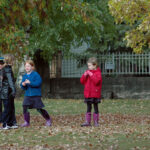Home »

BCDPC says 24 animals died in vain
Stetski suggests regional mayors think tank wildlife strategy
The B.C. Deer Protection Coalition says it is celebrating the end of the City of Cranbrook’s second deer cull program, which concluded last week after 24 mule deer were killed.
Stating in a press release that the city failed to meet its target of 30 deer, noting that six deer escaped “execution,” the BCDPC is saying the city is now making “a hasty retreat as controversy continues to swirl around the deer cull.”

Colleen Bailey, spokesperson for the BCDPC stated, “We are thrilled that the cull has finally ended. We are also thrilled that the city brought the cull to an end before achieving their target of 30 animals. We think the ongoing controversy had a lot to do with ending the cull early. We are sad that 24 innocent animals died in the fiasco but six escaped cruel confinement and execution.”
Devin Kazakoff, Invermere Deer Protection Society spokesperson added, “Cranbrook Council got what it deserved. It met in secret, it voted in secret, it spent tax dollars in secret and it told residents of Cranbrook that it was none of their business how it voted until after the cull was complete. Now that it has ended, council tells us that it agreed to spend $15,000 on the cull even though it knew that killing 30 deer as previously stated would have cost $18,750. At any rate, the decision was made without public oversight on the bid process, the cost and whether to have a cull at all.”
“Once again, 24 animals die in vain,” added Liz White, of the BCDPC. “As we have said repeatedly, indiscriminate trapping does not work. Of the 24 deer caught, 10 were adult does the city deems aggressive. That means that 59% of the animals caught and killed were not the target animals and about one-third of those were young of the year. We have repeatedly said that culls do not work. We have offered to assist with the development of a human/deer conflict prevention program and a non-lethal strategy where conflicts occur. It would be extremely helpful, for example, if the city proactively enforced the no feeding deer bylaw.”
Bailey concluded, “Once again, we offer our services to the city to assist in the development of a prevention program. The people of Cranbrook who have contacted me want to have open and transparent discussions about alternative approaches to culling.”

Meanwhile, Cranbrook Mayor Wayne Stetski suggested March 1 during the Regional District of East Kootenay (RDEK) board of directors meeting that regional mayors should form a think tank to consider urban wildlife issues and form a joint strategy, and not just for deer. “Skunks” are becoming the latest wildlife issue for the first-term mayor.
He invited mayors to “set up a strategy session for where we want to go in the future.”
City of Cranbrook Councillor Bob Whetham, like Stetski a member of the RDEK board, said “a lot of communities are struggling with wildlife” and suggested some study of American examples would benefit the region.
“For anyone struggling with it” he said he advised reading about their approaches to solutions.
For example, he said one American example pointed out that “carrying capacities” for providing ample food are much larger in urban areas, thanks to all the green lawns etc.
“We’ve created habitat, they’ve stayed and expanded their population,” Whetham said.
“Isn’t it funny how animals really don’t care about us? They find a patch of green and stay there,” noted Electoral Area A director Mike Sosnowski.
In related news, City of Kimberley Mayor Ron McRae informed fellow board members that his council has not made a decision yet to conduct a second cull, though they have a report recommending they do one.
e-KNOW







